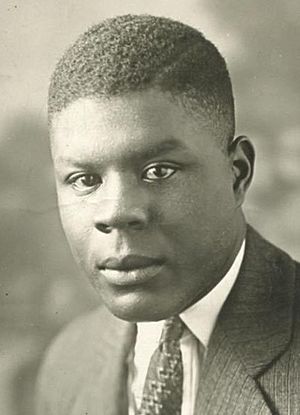John Beckwith (baseball) facts for kids
Quick facts for kids John Beckwith |
|||
|---|---|---|---|
 |
|||
| Utility infielder / Manager | |||
| Born: January 10, 1900 Louisville, Kentucky |
|||
| Died: January 4, 1956 (aged 55) New York City |
|||
|
|||
| debut | |||
| 1916, for the Montgomery Grey Sox | |||
| Last appearance | |||
| 1938, for the Brooklyn Royal Giants | |||
| Career statistics | |||
| Batting average | .349 | ||
| Hits | 636 | ||
| Home runs | 76 | ||
| Runs batted in | 461 | ||
| Stolen bases | 40 | ||
| Managerial record | 63–53–1 | ||
| Teams | |||
As player
As manager
|
|||
| Career highlights and awards | |||
|
|||
John Christopher Beckwith (born January 10, 1900 – died January 4, 1956) was a famous American baseball player. He was known as The Black Bomber because of how powerfully he hit the ball. John played as an infielder in the Negro leagues.
Contents
Early Life and Baseball Start
John Beckwith was born in Louisville, Kentucky. He had an older brother, Stanley Beckwith, who also played in the Negro leagues. John started his professional baseball career around 1916.
Playing for the Chicago Giants
In 1920, when he was 20 years old, Beckwith joined the Chicago Giants. This team traveled a lot to play games. Even though the team struggled, John was a great player. He hit for a high batting average, hitting .285 in 1920 and an amazing .371 in 1921.
Joining the Chicago American Giants
After his strong performance, Rube Foster, who owned the Chicago American Giants, bought John Beckwith for his team. In 1922, John continued to play well, hitting .358. He also helped his team win the Negro National League championship that year. He played one more season with them, hitting .304.
Powerful Hitting and Other Teams
John Beckwith was known for his very long, 38-inch bat and his incredible power. He often hit over .300, which is a very high batting average. In 1927, he hit an amazing 72 home runs in unofficial games. The next year, he hit 54 home runs.
He later played for the Baltimore Black Sox starting in 1924. In 1925, he hit .404 with 15 home runs! This was one of his best seasons, though he finished second in batting average to another great player, Oscar Charleston. John also played for the Harrisburg Giants and the Homestead Grays. He continued to play baseball until 1938.
Playing Different Positions
John Beckwith was a very versatile player. He could play almost anywhere on the field! He mostly played third base and shortstop. He even pitched a few times. His strong arm allowed him to play many different positions.
As a Manager
Besides playing, John Beckwith also managed baseball teams. He was a manager for three different teams:
- The Baltimore Black Sox in 1925.
- The Harrisburg Giants in 1927, where his team finished in second place.
- The Newark Browns in 1932.
John Beckwith's Legacy
John Beckwith was one of the most powerful hitters in the Negro leagues. He was a huge player, standing 6 feet 3 inches tall and weighing over 220 pounds. Many people who saw him play said he was as strong as, or even stronger than, famous players like Babe Ruth and Josh Gibson.
Ted "Double Duty" Radcliffe, another baseball legend, said that "nobody hit the ball any farther than [Beckwith]." Babe Ruth himself reportedly said that Beckwith could hit harder than "any man in the world." One time, he hit a ball 460 feet in Griffith Stadium!
John Beckwith's impressive career statistics show his impact. He was often among the top players in batting average, home runs, and RBI (runs batted in) in the Negro leagues. He died in New York City in 1956, just before his 56th birthday.

